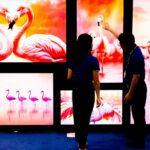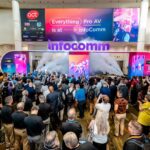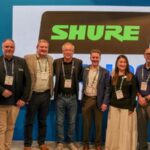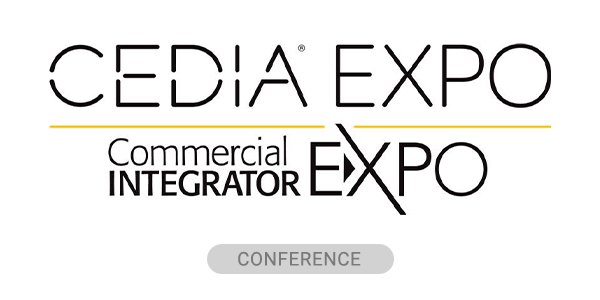For the fifth consecutive year, Electrosonic has been honored with the 2023 Commercial Integration Award for Best Museum Project! At the First Light Exhibition at Jodrell Bank Observatory, the Orlando, Fla.-based integration firm created an innovative and inspiring exhibition space for visitors of all ages by bringing to life the story of radio astronomy.
Project Background
The First Light Exhibition at Jodrell Bank Observatory narrates the history of radio astronomy and its impact on exploring the universe. Here, innovative experiential technology brings 50 years of intergalactic discoveries to life for a digitally aware audience.
Visitors enter the cavernous domed black space and come into direct contact with reclaimed ‘shards’ of the original metal dish that has ‘listened’ to the heavens and been touched by cosmic rays. Above them, they see the ‘Radio Sky,’ a unique projection surface created from some of the ‘shards.’
When visitors explore the interactive exhibits, they trigger images and special effects projected onto the Radio Sky. Although each of the shards feature content from individual chapters; the control system brings them together at set times in a circular array to create a huge multiple projection screen.
The organizers also wanted to attract a wider audience to Jodrell Bank. Here, they recognized that experiential technology and interactivity are essential to engage digitally aware visitors of all ages. At the same time, they wanted to retain the spirit and feel of this historically significant site.
Bringing in Electrosonic
The Jodrell Bank team thus engaged exhibition designers Casson Mann to develop a scheme that would achieve the goals and the balance they needed. The designers recommended a unique conceptual approach to the project. This approach would take advantage of the opportunity provided by conservation work on the original Lovell Telescope.
The team thus decided to use 15 ‘shards’ from the telescope to form the basis of the exhibition. Some of them would be for creating the Radio Sky; while others would be ‘props’ for some of the physical exhibits.
Casson Mann recognized that this complex large-scale project required unique audiovisual engineering and integration skills and experience in developing projection and control systems for mapping content on complex surfaces. It also required an ability to collaborate with partners from initial concept to handover to ensure continuity and deliver a seamless solution that was achievable, reliable and maintainable.
The designers then brought in Electrosonic to design the technical aspects of the exhibition. Electrosonic worked in partnership with fitout contractors Realm Projects. Together, they aimed to deliver the audiovisual, physical network infrastructure as well as the control system design, build and system integration to bring the vision to life.
Addressing Main Challenges
The major challenge was programming and commissioning the complex projection mapping solution. This required precise positioning of 17 projectors; complex configuration and integration of video servers, projectors and interactive exhibits; and precise layering of projected content and sophisticated control systems.
Each interactive exhibit can trigger individual images or films onto the larger background projections. Thus, the team had to carefully consider the impact of the orchestration and ensure that the show could work visually at all times.
When the intelligent control system brings the individual shards together, the ‘Radio Sky’ becomes a single, seamless circular array creating a huge multiple projection surface for mind-blowing images of the universe.
Electrosonic worked closely with Casson Mann throughout the development phase to design the complex technical systems. Electrosonic’s engineering team further developed the technical design using skilled audiovisual design, 3D modelling and large-scale mock-ups. With this, it ensured that the projection-mapping solution would deliver the creative vision.
In addition to engineering and integrating the complex projection mapping and soundscapes, Electrosonic helped integrate the audio and the technologies for all digital exhibits. This included 15 interactive touchscreens, 10 monitors, seven audio-only exhibits and multiple speakers for all exhibits.
The audio system provides 13 channels for ambient audio playback. At key points, the audio has to change in synch with interactive triggered events. Full-channel audio is also required for a main show, ‘The Universe.’ The control system incorporates two servers to provide ambient audio and separate audio for triggered events or shows.
By incorporating this, Electrosonic reveals that the result is a spectacular, fun, immersive space that is a fitting tribute to Jodrell Bank’s proud heritage.
First Light Exhibition – Equipment list
- 7th Sense servers
- Apart loudspeakers
- Audac amplifiers
- Brightsign media players
- Epson laser projectors
- Extron amplifiers
- Ilyama touchscreens
- Medialon controllers
- NEC displays
- Tannoy loudspeakers
An Engaging Experience
Within the exhibition, the six ‘chapters’ tell different aspects of the story. Each chapter features a mix of physical exhibits, graphics, video, audio, touchscreens, simulations and interactives. Visitors can experience the thrill of a meteor shower, crawl into a black hole and try ‘driving’ a radio telescope.
The six chapters are as follows:
- Ways of Seeing – what is radio astronomy?
- Bernard Lovell – introducing Lovell and Jodrell Bank
- The Fairground – early days at Jodrell Bank
- The Telescope – building the telescope
- The Miracle of Sputnik – the miracle that saved the telescope
- The Impact of Jodrell Bank
Diving into The Six Chapters
Ways of Seeing introduces radio astronomy with interactive exhibits that explain the concept of Chromoscope frequencies. Here, the story of Bernard Lovell features a ‘family album.’ This is an interactive touchscreen explaining his work in radar, while the audio highlights his love of music.
The Fairground looks back at the site’s early days using a projected model surrounded by five interactive screens. Another interactive explains the concept of Interferometry.
The Telescope chapter enables visitors to explore the evolution of the design of the first telescope on an interactive touchscreen. They can also view a projected recreation of Lovell’s desk or listen to audio describing the construction.
In the Miracle of Sputnik chapter, visitors can drive a telescope by using touchscreen controls. They can also explore the work of the telescope during the Cold War on an interactive Logbook.
The Impact of Jodrell Bank features a Conversation Table touchscreen exhibit where visitors can select discussions on its impact. It also has a Visitor Quiz that triggers projected images when answers are correct.
Within the gallery, the exhibits have an individual soundtrack or audio specific to each story; however, there is also a soundscape across the entire space. This provides a low level of audio to mask audio leaking between exhibits and provide a larger feel when the projected elements work together across the gallery.
Praise for First Light
Teresa Anderson, director of Jodrell Bank Centre for Engagement, comments, “It is a project that has involved an incredible team of creative, skilled, and committed people, all of whom have put their hearts into it. The result is something really special and unique — there is nothing like it anywhere in the world — and it will stand at Jodrell Bank for generations to come, offering people of all ages a chance to be inspired by our place in the Universe.”
Amy Bishop, head of marketing, Jodrell Bank Visitor Centre, adds, “First Light opened in June (2022) and is proving popular with visitors. It is attracting a more diverse audience and they are staying longer than previously.”
Commentators have also praised the impact of the exhibition. According to Building Magazine, “the approach to Jodrell Bank Observatory’s new First Light Pavilion is designed to instill a sense of surprise and wonder.”
The exhibition was awarded the ‘Exhibiting Excellence’ Large Exhibition prize by the British Society for the History of Science. Here, the judges noted that the exhibition structure of short ‘chapters’ offered visitors a range of different ways to engage with the stories being told. In particular, they praised the integration of the panels of the original surface of the Lovell Telescope into the exhibition. They also underlined the way that the architecture of the building itself was also used to express the narrative.
Click on “View Slideshow” for additional images of the First Light Pavilion at Jodrell Bank. All images courtesy of Electrosonic.





































